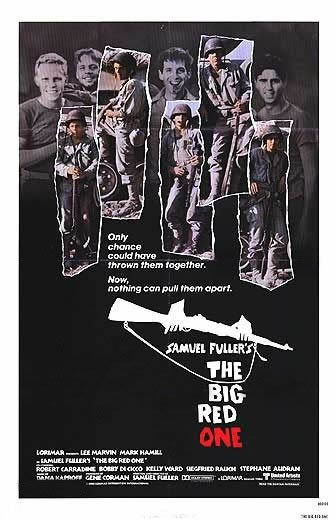Movies

New Releases • A-D • E-H • I-P • Q-Z • Articles • Festivals • Interviews • Dark Knight • Indiana Jones • John Wick • MCU
The Big Red One: The Reconstruction
Directed by Samuel Fuller
A conversation about the new version shown at DIFF27
by Matt Anderson, Marty Mapes

Marty Mapes: Someone thought The Big Red One earned a "reconstruction," but I thought it was just another World War II film, in some respects. I guess there are many types of WWII films. This is the type with fresh-faced infantry from different parts of the country, fighting in exotic locales, waiting to see who lives and who dies.
The "One" from the title is the first infantry division, and the movie follows a rifle squad from that division to just about every important battle of WWII. It starts with them in Italy, then they travel to North Africa, and finally make their way into Europe. If I had to compare it to another film, it'd be Saving Private Ryan, which was also a "tour" of the war.
Matt Anderson: I agree with your comments. It is a long, interesting journey, but it just doesn't add up to much.
Saving Private Ryan had the benefit of a story that tied things together; the episodes were part of a bigger picture that culminated with Tom Hanks delivering that famous line, "Earn this."
Here, we've got Lee Marvin delivering quips like "I think you"ve got him" to Mark Hamill, who repeatedly fires at a soldier he's killed in an oven. Hamill is supposed to relieving his suppressed aggression, but the scene goes on for too long and it ultimately loses its impact.
MM: The Big Red One is now 154 minutes long. The version released to U.S. theaters in 1980 was 113 minutes. The reconstruction, completed this year, is being released 7 years after the death of director Samuel Fuller, who himself was a soldier in the first infantry. This reconstruction is based on Fuller's original notes.
Not having seen the original theatrical cut, I can't say what was different or whether the film was improved. But based reviews of the original release, it sounds like the film hasn't been greatly improved. I agree with the 1980 critics who said the film is episodic, feels like a series of thinly-related vignettes, and falls a little short of greatness, while still being a very good portrait of World War II.
MA: I did see the original when it first played in theaters, but I don't remember it very well. I was surprised to learn of this reconstruction making the festival circuit.
As for the end result, the picture quality was particularly distracting; it felt like there was still a lot of work to be done to make the movie whole.
MM: Yeah, I noticed some video-looking artifacts on the screen, even though we watched a film projection.
MA:It's interesting that it's been subtitled "The Reconstruction" rather than "The Restoration" because "reconstruction" does kind of have a connotation of a hammer and chisel rather than a carefully choreographed restoration along the lines of what was done with Lawrence of Arabia several years ago.
MM: If the film has a "message," it's contained in the opening scene with Lee Marvin killing a World War I German soldier a few hours after the war had ended (but before the news had reached them). A parallel scene at the end of the movie gives the film an "arbitrariness of war" theme that may or may not have been present in the original version.
MA: While it starts out with the title card "this is fictional life based on factual death," there's something about the movie that fails to resonate. Maybe it's that oddball, gung-ho American humor that makes it feel more like a G.I. Joe cartoon than a fact-based war movie. There were also a couple character actors from Spielberg's 1941; that only served to further confuse what kind of movie it was trying to be since it was hard to take them seriously. A cameo appearance by Wild Bill Kelso seemed to be just around the corner; it's just a shame that one never materialized.
Instead, we get Lee Marvin chomping on a cigar through an Arab "bed sheet." That has the same over-the-top spirit as John Belushi's beer-swigging, cigar-hungry soldier of glory. And it's kind of scary that a "serious" war film like The Big Red One would lend itself to comparisons to 1941. Maybe it's because they were released so close together (1941 came out in 1979 and The Big Red One followed in 1980).
But, at least Marvin is in good form delivering his one liners: "I can understand your being horny, but you"ve got bad breath," he says to a doctor looking after more than his care.
I certainly don't recall that rather racy scene from the original.
MM: Which one is that?
MA: The one with the Axis doctor attempting to make out with Marvin. I also don't recall the scene with the soldiers helping a woman give birth in a tank, the soldiers laying the groundwork for McGyver, putting condoms and bandoliers to use in a whole new capacity.
While I don't recall those scenes being in the original, I kept waiting for Mark Hamill to get killed, so I obviously don't remember the original very well. However, I do vaguely recollect a "controversy" about how Luke Skywalker was playing a wimpy, gun-shy character in The Big Red One.
• Originally published at MovieHabit.com.


